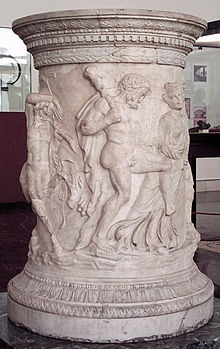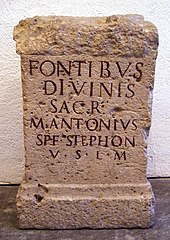

Fontus or Fons (pl.: Fontes, "Font" or "Source") was a god of wells and springs in ancient Roman religion. A religious festival called the Fontinalia was held on October 13 in his honor. Throughout the city, fountains and wellheads were adorned with garlands.
Fontus was the son of Juturna and Janus. Numa Pompilius, second king of Rome, was supposed to have been buried near the altar of Fontus (ara Fontis) on the Janiculum. William Warde Fowler observed that between 259 and 241 BC, cults were founded for Juturna, Fons, and the Tempestates, all having to do with sources of water. As a god of pure water, Fons can be placed in opposition to Liber as a god of wine identified with Bacchus.
An inscription includes Fons among a series of deities who received expiatory sacrifices by the Arval Brothers in 224 AD, when several trees in the sacred grove of Dea Dia, their chief deity, had been struck by lightning and burnt. Fons received two wethers. Fons was not among the deities depicted on coinage of the Roman Republic.
The gens Fonteia claimed to be Fontus' descendants.
In the cosmological schema of Martianus Capella, Fons is located in the second of 16 celestial regions, with Jupiter, Quirinus, Mars, the Military Lar, Juno, Lympha, and the Novensiles.
Fons Perennis
Water as a source of regeneration played a role in the Mithraic mysteries, and inscriptions to Fons Perennis ("Eternal Spring" or "Never-Failing Stream") have been found in mithraea. In one of the scenes of the Mithraic cycle, the god strikes a rock, which then gushes water. A Mithraic text explains that the stream was a source of life-giving water and immortal refreshment. Dedications to "inanimate entities" from Mithraic narrative ritual, such as Fons Perennis and Petra Genetrix ("Generative Rock"), treat them as divine and capable of hearing, like the nymphs and healing powers to whom these are more often made.
Honours
Fontus Lake in Antarctica is named after the deity.
References
- Stephen L. Dyson, Rome: A Living Portrait of an Ancient City (Johns Hopkins University Press, 2010), p. 228. Described by Varro, De lingua latina 6.3: "The Fontanalia Fontus, because it's his holiday (dies feriae); on account of him then they toss wreaths into fountains and garland puteals" (Fontanalia a Fonte, quod is dies feriae eius; ab eo tum et in fontes coronas iaciunt et puteos coronant). Festus also mentions the rites (sacra).
- Arnobius, Adversus Nationes 3.29.
- Cicero, De legibus 2.56 and De natura deorum 3.52; Samuel Ball Platner, The Topography and Monuments of Ancient Rome (1904), p. 488.
- William Warde Fowler, The Religious Experience of the Roman People (London, 1922), p. 285, with a speculation that this was a response to the naval activity of the First Punic War.
- As when two characters argue over which holds imperium in Plautus's Stichus, line 696ff.; Thomas Habinek, The World of Roman Song (Johns Hopkins University Press, 2005), p. 186.
- Mary Beard, J.A. North, and S.R.F. Price, Religions of Rome: A Sourcebook (Cambridge University Press, 1998), p. 152.
- Michael H. Crawford, Roman Republican Coinage (Cambridge University Press, 1974, 2001), p. 914.
- Martianus Capella, The Marriage of Philology and Mercury 1.46 online.
- Vivienne J. Walters, The Cult of Mithras in the Roman Provinces of Gaul (Brill, 1974), p. 47.
- Richard Gordon, "Institutionalized Religious Options: Mithraism," in A Companion to Roman Religion (Blackwell, 2007), p. 398.
- Fontus Lake. SCAR Composite Gazetteer of Antarctica
Further reading
- Visočnik, Julijana. "Čaščenje Nimf in Fontana v vzhodnoalpskem prostoru" In: Studia Historica Slovenica: Časopis za humanistične in družboslovne študije , letnik 20 (2020), št. 1, pp. 11-40. DOI: 10.32874/SHS.2020-01
External links
 Media related to Fontus at Wikimedia Commons
Media related to Fontus at Wikimedia Commons
| Ancient Roman religion and mythology | ||
|---|---|---|
| Deities (Dii Consentes) |  | |
| Legendary figures | ||
| Legendary beings | ||
| Texts | ||
| Concepts and practices | ||
| Philosophy | ||
| Events | ||
| Objects | ||
| Variations | ||
| See also | ||